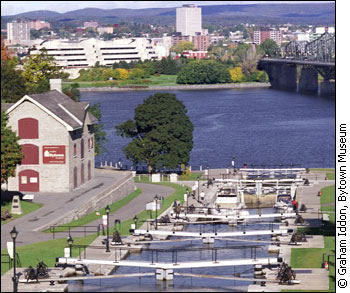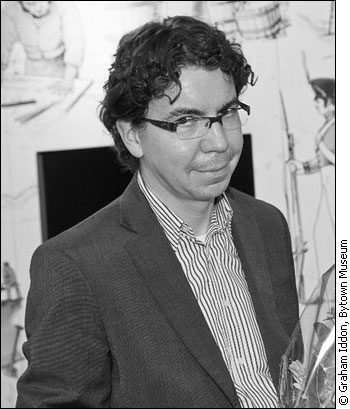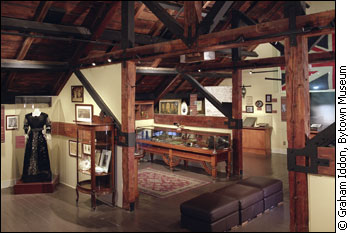Tags
Related Posts
Share This
Adding some ‘story’ to history, the Bytown Museum goes modern

A hidden gem, the Bytown Museum stands beside the Ottawa locks.
The lights are on at the Bytown Museum along the Rideau locks on a cold winter day, but is anyone home?
Step into the warmly lit museum and, yes, it is now open for the winter season. Walk upstairs and there will be more than the traditional historical artifacts of old Ottawa; in the temporary galleries, an exhibit features local artists’ self-portraits—an unexpected departure from the museum’s usual city-history fare.
The Bytown Museum is making efforts to rejuvenate itself by taking a new approach that involves engaging the community. These efforts have been in the works for the last two years. Among the new measures, the museum is updating its website, staying open during the fall and winter season and, in a recent bold move, adding temporary exhibits reflecting modern-day Ottawa life.
“The museum will continue to remain a history museum. However, we’ve been able to shed the image of being a ‘dusty old museum’ and we are becoming a more relevant, community-focused museum,” says Mike Steinhauer, the Bytown Museum’s director.
Steinhauer’s decision here was the result of a year-long conversation with the board of directors and stakeholders. “It became apparent that we needed to broaden our audience and develop programming that is fresh and relevant,” he says.
Over the last year, the museum has been hosting more contemporary exhibits, such as “Many Guises: Contemporary Self-Portraits.” Six local artists have provided self-portraits paired with another photograph, to enhance the resultant narrative and character portrayal.
‘We’ve been able to shed the image of being a “dusty old museum” and are becoming more relevant, community-focused.’ – Mike Steinhauer
This temporary exhibit is being paired with a historical exhibit called “Likeness: Historic Photographs from the Bytown Museum Collection.” Combined, the two exhibits provide a more direct link to Ottawa’s past and present.
However, Steinhauer says, at first not everyone was keen on the new mandate of the museum. “Implementing change in any organization, regardless of how progressive it is, can be difficult. The Bytown Museum is Ottawa’s oldest community museum and thus certain people expected us to do certain things,” he says.
There were people who thought the idea of bringing contemporary exhibits to a traditional, historical museum would change the institution’s entire image and purpose. This has not been the case; instead, the contemporary exhibits have added depth and character to the permanent exhibits.
The new approach is being well received by the community, Steinhauer says. According to visitor statistics, local residents are once again coming to the museum; this has helped maintain strong visitor numbers over the last two years, despite an overall dip in Ottawa tourism.
Seeking a wider appeal
Increasingly, museums in North America are developing fresh ways to engage their audiences. Pairing contemporary exhibits with historical ones offers a new perspective on old artifacts. Also, it creates a more varied program, to appeal to a wider demographic and to encourage repeat visits.
Says Charles Akben-Marchand, heritage chair of the Centretown Citizens Community Association, “The Bytown Museum’s recent exhibits that show Ottawa’s recent and present history help to provide a tangible link that serves as a valuable starting point for people to reconnect with a lost past.”

Kicking up dust: Mike Steinhauer, museum director since 2009.
Bruce Elliott, a Carleton history professor and volunteer historian at Pinhey’s Point Museum, agrees. “They certainly don’t need to apologize for including aspects of contemporary Ottawa in what they do, though I wouldn’t want the temporary galleries to be used always and only for that,” he says. He stresses the importance of having both historical and contemporary exhibits rotating through the temporary galleries, to create balance.
Elliott says the Nepean Museum had a similar idea of displaying the works of current Nepean residents. “It was part of that institution’s commitment to being ‘Your Nepean Museum,’ and I always thought it was a great idea,” he says.
Both the Bytown and Nepean museums are part of this greater wave to include contemporary aspects in exhibits, thereby offering a more complete context.
While museums’ efforts to engage communities are generally receiving a warm welcome across North America, Douglas Worts, a culture and sustainability specialist in Toronto, recommends looking a little deeper. “Museums assume whatever they do has a positive impact, but they never test it,” he says. He applies this notion to any new idea a museum may want to bring in, be it contemporary exhibits or interactive components, etc.
The best way to measure success, according to Worts, is to measure the strategic impacts. He says that to test the success of a museum’s impact, there are several levels to look at: individual, community, institutional and global. This includes evaluating whether the exhibit (a) provokes curiosity, (b) relates to issues facing the community and (c) sheds new light on the cultural issues of the day.
Measuring success
“Is the experience useful? Is there greater awareness on a given issue of the day?” Worts asks. These impacts are difficult to measure, but directors can use online and on-location surveys, individual interviews with guests, guestbooks, and other similar tools to gauge the impact at different levels.
Steinhauer says he measures success “by positive feedback from participants, visitors and the Board of Directors of the Bytown Museum. Attendance is also be an indicator of success.” The newer exhibits have caused an increase in visitor numbers at the museum, and Steinhauer says this is one of the main ways to prove they have been successful.
Worts says measuring success is more than that. “To me, a museum is a cultural organization that really needs to orient vibrancy and well-being within in the community,” he says. Measuring attendance numbers and positive feedback is only just the beginning, Worts says: The audience needs to take something away from the museum, something they’ve learned and can apply in a global context.
Worts reinforces, though, that the Bytown Museum seems to be taking the right steps. “It sounds like the director is heading in an interesting direction of community engagement.”

Historical artifacts remain the Bytown’s key elements, despite the arrival of modern-themed exhibits.
Steinhauer acknowledges the importance of community engagement that Worts highlights, which is why he is excited that the museum’s new mandate has allowed him to further explore and develop community engagement.
“The museum is a place not just about the community, but a place for and by the community,” Steinhauer says.
Front page photo courtesy of Graham Iddon, Bytown Museum
Related Links





